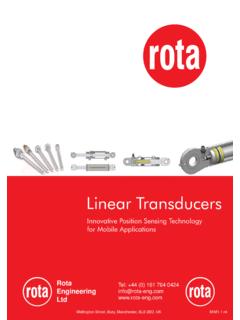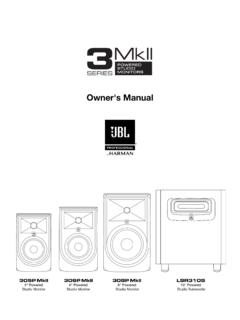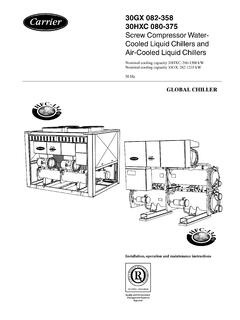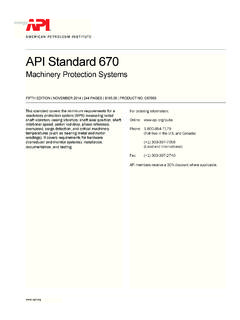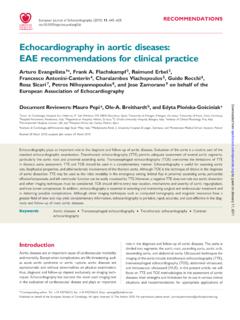Transcription of UNIT II: Transducers Definition of transducers Classification …
1 LECTURE NOTES. UNIT II: Transducers Definition of Transducers Classification of Transducers Advantages of Electrical Transducers . Characteristics and choice of Transducers Principle operation of resistor, inductor, LVDT and capacitor Transducers LVDT Applications Strain gauge and its principle of operation Guage factor Thermistors Thermocouples Synchros Piezo electric Transducers Photo diodes. INTODUCTION. A device which converts a physical quantity into the proportional electrical signal is called a transducer . The electrical signal produced may be a voltage, current or frequency. A transducer uses many effects to produce such conversion. The process of transforming signal from one form to other is called transduction. A transducer is also called pick up. The transduction element transforms the output of the sensor to an electrical output, as shown in the Fig.
2 A transducer will have basically two main components. They are 1. Sensing Element The physical quantity or its rate of change is sensed and responded to by this part of the transistor. 2. Transduction Element The output of the sensing element is passed on to the transduction element. This element is responsible for converting the non-electrical signal into its proportional electrical signal. There may be cases when the transduction element performs the action of both transduction and sensing. The best example of such a transducer is a thermocouple. A thermocouple is used to generate a voltage corresponding to the heat that is generated at the junction of two dissimilar metals. Classification of Transducers The Classification of Transducers is done in many ways. Some of the criteria for the Classification are based on their area of application, Method of energy conversion, Nature of output signal, According to Electrical principles involved, Electrical parameter used, principle of operation, & Typical applications.
3 The Transducers can be classified broadly i. On the basis of transduction form used ii. As primary and secondary Transducers iii. As active and passive Transducers iv. As Transducers and inverse Transducers . Broadly one such generalization is concerned with energy considerations wherein they are classified as active & Passive Transducers . A component whose output energy is supplied entirely by its input signal (physical quantity under measurement) is commonly called a passive transducer . In other words the passive Transducers derive the power required for transduction from an auxiliary source. Active Transducers are those which do not require an auxiliary power source to produce their output. They are also known as self generating type since they produce their own voltage or current output.
4 Some of the passive Transducers ( electrical Transducers ), their electrical parameter (resistance, capacitance, etc), principle of operation and applications are listed below. Resistive Transducers 1. Resistance Strain Gauge The change in value of resistance of metal semi-conductor due to elongation or compression is known by the measurement of torque, displacement or force. 2. Resistance Thermometer The change in resistance of metal wire due to the change in temperature known by the measurement of temperature. 3. Resistance Hygrometer The change in the resistance of conductive strip due to the change of moisture content is known by the value of its corresponding humidity. 4. Hot Wire Meter The change in resistance of a heating element due to convection cooling of a flow of gas is known by its corresponding gas flow or pressure.
5 5. Photoconductive Cell The change in resistance of a cell due to a corresponding change in light flux is known by its corresponding light intensity. 6. Thermistor The change in resistance of a semi-conductor that has a negative co-efficient of resistance is known by its corresponding measure of temperature. 7. Potentiometer Type The change in resistance of a potentiometer reading due to the movement of the slider as a part of an external force applied is known by its corresponding pressure or displacement. Capacitance Transducers 1. Variable capacitance pressure gage - Principle of operation: Distance between two parallel plates is varied by an externally applied force Applications: Measurement of Displacement, pressure 2. Capacitor microphone Principle of operation: Sound pressure varies the capacitance between a fixed plate and a movable diaphragm.
6 Applications: Speech, music, noise 3. Dielectric gauge Principle of operation: Variation in capacitance by changes in the dielectric. Applications: Liquid level, thickness Inductance Transducers 1. Magnetic circuit transducer Principle of operation: Self inductance or mutual inductance of ac-excited coil is varied by changes in the magnetic circuit. Applications: Pressure, displacement 2. Reluctance pickup Principle of operation: Reluctance of the magnetic circuit is varied by changing the position of the iron core of a coil. Applications: Pressure, displacement, vibration, position 3. Differential transformer Principle of operation: The differential voltage of two secondary windings of a transformer is varied by positioning the magnetic core through an externally applied force.
7 Applications: Pressure, force, displacement, position 4. Eddy current gage Principle of operation: Inductance of a coil is varied by the proximity of an eddy current plate. Applications: Displacement, thickness 5. Magnetostriction gauge Principle of operation: Magnetic properties are varied by pressure and stress. Applications: Force, pressure, sound Voltage and current Transducers 1. Hall effect pickup Principle of operation: A potential difference is generated across a semiconductor plate (germanium) when magnetic flux interacts with an applied current. Applications: Magnetic flux, current 2. Ionization chamber Principle of operation: Electron flow induced by ionization of gas due to radioactive radiation. Applications: Particle counting, radiation 3. Photoemissive cell Principle of operation: Electron emission due to incident radiation on photoemissive surface.
8 Applications: Light and radiation 4. Photomultiplier tube Principle of operation: Secondary electron emission due to incident radiation on photosensitive cathode. Applications: Light and radiation, photo-sensitive relays Self-Generating Transducers (No External Power) Active Transducers They do not require an external power, and produce an analog voltage or current when stimulated by some physical form of energy. 1. Thermocouple and thermopile Principle of operation: An emf is generated across the junction of two dissimilar metals or semiconductors when that junction is heated. Applications: Temperature, heat flow, radiation. 2. Moving-coil generator Principle of operation: Motion of a coil in a magnetic field generates a voltage. Applications: Velocity. Vibration 3.
9 Piezoelectric pickup An emf is generated when an external force is applied to certain crystalline materials, such as quartz Sound, vibration. acceleration, pressure changes 4. Photovoltaic cell Principle of operation: A voltage is generated in a semi-conductor junction device when radiant energy stimulates the cell Applications: Light meter, solar cell Primary Transducers and Secondary Transducers - Bourden tube acting as a primary detecter senses the pressure and converts the pressure into a displacement of its free displacement of the free end moves the core of a linear variable differential transformer(LVDT) which produces an output voltage. Analog Transducers -These Transducers convert the input quantity into an analog output which is a continuous function of time.
10 Strain Gauge LVDT Thermocouple Thermistor Digital Transducers -These Transducers convert the input quantity into an electrical output which is in the form of pulses. Glass Scale can be read optically by means of a light source,an optical system and photocells Transducers and Inverse Transducers - -A transducer can be broadly defined as a device which converts a non-electrical quantity into an electrical quantity. Ex:-Resistive,inductive and capacitive Transducers -An inverse transducer is defined as a device which converts an electrical quantity into a non-electrical quantity. Ex:-Piezoelectric crystals Advantages of Electrical Transducers Mostly quantities to be measured are non-electrical such as temperature, pressure, displacement, humidity, fluid flow, speed etc.


